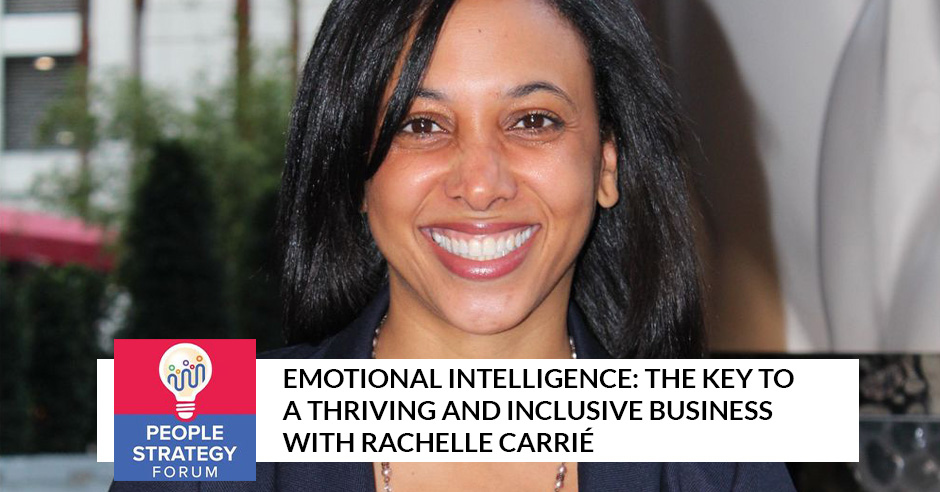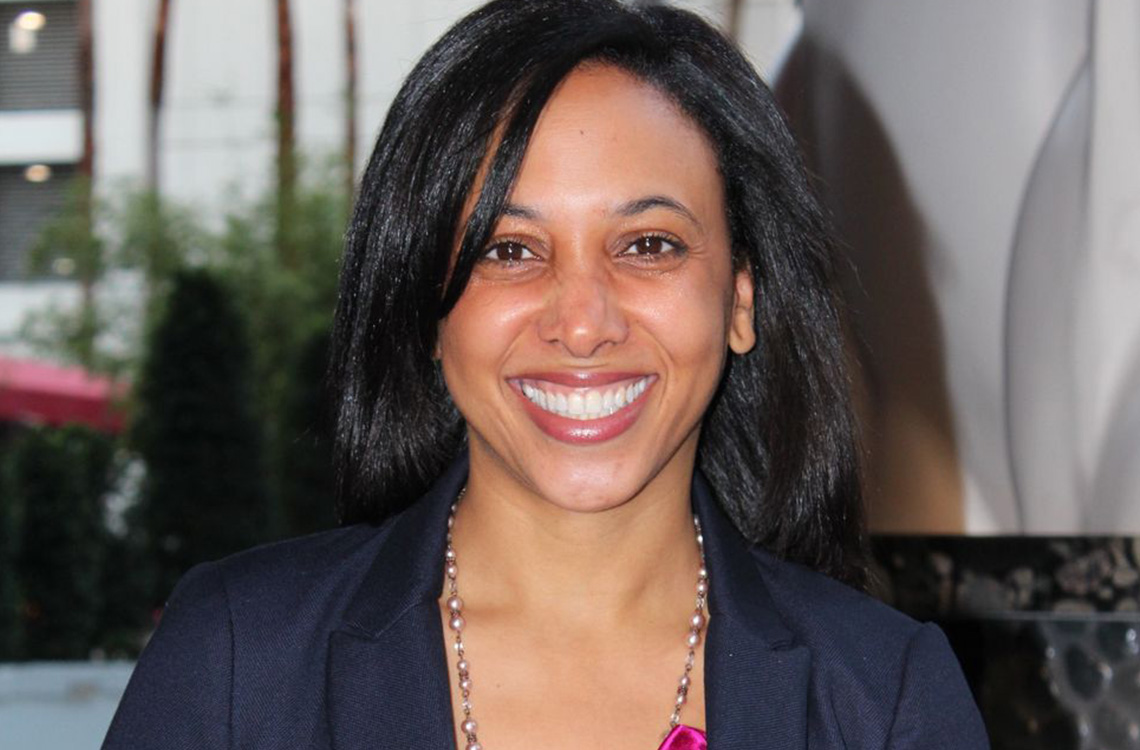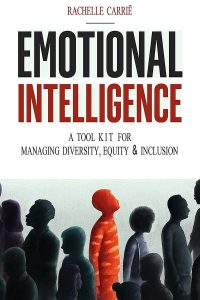Emotional Intelligence: The Key To A Thriving And Inclusive Business With Rachelle Carrié

Often, the skills that matter are what many consider soft. But if there is anything more pronounced in this podcast, it is that nothing is soft about making your organization people-centric. One of those skills is emotional intelligence. In today’s conversation, we dive deep into its role in building a thriving and inclusive business. Joining us is the Founder of SEQ Consulting, Rachelle Carrié, who shares her experiences and strategies for helping build human-centric businesses through the power of emotional intelligence. She also talks about how to build this muscle and what actions leaders should take to create psychological safety within the team. Going further, Rachelle discusses the impact of emotional intelligence on DEI, then gives us a peek into her books on emotional intelligence and leadership. Push the needle forward by building a people-centric business. Follow this episode to learn more!
—
Emotional Intelligence: The Key To A Thriving And Inclusive Business With Rachelle Carrié
In this episode, we have the honor of hosting a true visionary and advocate for inclusive workplaces. Please join me in welcoming our special guest, Rachelle Carrié. Rachelle is the Founder of SEQ Consulting, a boutique firm dedicated to developing inclusive work environments through an emotionally intelligent lens with a wealth of experience spanning over 50 years in her corporate education and all others on her team.
Rachelle brings a unique perspective to the table as a fearless consultant advocating and an author. She has been at the forefront of driving meaningful change within organizations. She is passionate about collaboration and believes in the power of amplifying impact through sharing knowledge and resources and creating an inclusive culture.
Rachelle’s groundbreaking books, which include Emotional Intelligence: A Tool Kit for Managing Diversity, Equity & Inclusion and Know Yourself To Know Your Employees, have both been widely acclaimed and are available on Amazon. Get ready to gain insights into the world of Emotional Intelligence: Diversity, Equity & Inclusion as Rachelle shares her experiences and strategies for building thriving businesses in an inclusive mindset.
—
Rachelle, I would love to hear a little bit more about you if we could dive into your background. How did you get to where you are in helping leaders know more about emotional intelligence, EQ and how to lead their teams better?
How I got into it by working within different organizations and school boards as well in the public and private sector and not-for-profit industry. I realized that there was a very high turnover. People were quiet leaving. It seemed over the years as I was compiling information that a lot of workplaces were toxic. In those workplaces being toxic, people were psychologically affected by it and not outputting and giving their best. I was guilty of doing that as well not because I didn’t want to work but because it wasn’t a psychologically safe environment anymore and not being able to put a word to it.
With the research and the educational degrees that I’ve amassed over the years, I realized that what it comes down to is emotional intelligence and how we’re able to communicate with others on a people level. Hence, people strategy forum. How are we relating from our heart to your heart? How are we welcoming you? What languages are we using? It’s not about the celebration of X month and what happens in December and February but it’s how we globalize our language to be able to allow people to feel more included. That comes within us.
There’s been a huge movement towards humanizing the workforce, especially in the past few years. We’ve focused on how important it is to be teaming and collaborating with our people more on a peer-to-peer basis instead of this command and control of the old days. That is starting to bring more awareness of greater inclusion. More emotional intelligence is needed for leaders to be able to navigate this space because things are quickly changing. We moved into a fully remote workplace a couple of years ago and now we’re in a hybrid area. Things are still struggling back and forth. What have your leaders been struggling with?
I believe a lot of my clients were struggling with remaining in a fixed mindset. A fixed mindset is having a limited belief of how they view themselves and then transferring it onto others unknowingly. A clear example would be we all have a home life before we come to work or enter our little workspaces. Whatever happens at home is usually transferred into our workplace.
One of the things that I’ve heard many times was not understanding why people have a certain body language when they come into work and why people are launched over. There are so many things that you can read in the body language where it’s apparent that something happened but it’s not being addressed in the workplace because they tend to see work as work.
It’s very hard to be able to fulfill your work tasks if you’re not feeling included or someone’s not asking, “How was your morning?” As opposed to, “How are you?” “I’m fine.” The open-ended questions, which were what I was saying, are important. “How are you feeling? You don’t look good. How is everything?” That already opens up a human-centric. It removes the barriers and people are able to connect a little bit more. Once they feel connected, then they can work and achieve better and greater results. That’s what the clients have mentioned to me and that’s helpful.
I don’t know what you think Sumit but I often find that leaders are often ill-prepared to be aware of their surroundings because they have a lot of different pressures and responsibilities. What are your thoughts there?
I’ve got a slightly conflicting opinion about this. I can’t remember where I watched this. I think it was a Netflix show where this person is a cult leader. They’re talking about emotional intelligence and the fact that high EQ enables them to draw people into their cult and create an ongoing set of folks who are out acting as serial killers.
After reading a little bit about EQ, I started believing that it’s a tool. It’s not an end in itself. Building emotional intelligence or an emotional portion does not mean you’ll get the right results in an organization. It probably means that you’ve got a tool. It’s like nuclear fusion. You can use it to generate electricity. You can also use it to destroy nations. I’d be very keen to understand what Rachelle thinks of this.
When we talk about emotional intelligence, it’s understanding that your actions impact others. It’s a way to build a stronger relationship with your staff to create a culture of trust, respect and collaboration within the team. When we think of an emotionally intelligent team, it’s one that understands that working together can improve outcomes while helping reduce stress, benefiting everyone that’s involved and recognizing that the importance of the skill is able to transfer itself to a more positive work environment so that everyone can reach their maximum potential.
When we talk about emotional intelligence, it's understanding that your actions impact others. Share on XWhat can leaders do to ensure that they can create teams that are aware and use emotional intelligence in a people-centric way or a positive way with their teams to ensure that we’re avoiding some of the negative behaviors that Sumit was highlighting?
There are a few things that you can do to build an EQ-centered workplace culture. It’s to encourage open and honest communication and also to be able to train employees in emotional intelligence and set the tone for this. As leaders, what’s important is that we take the time to invest in it and ask for feedback. A lot of times, we don’t know how the team is functioning, how they’re working or how they feel. Anonymous feedback, I believe, is something that’s very important. Also, surveys so that you can gauge and sense the pulse of the team. That’s when you know what’s going on. Especially, the fact that it’s anonymous, it’s the best way to be able to see what’s working and what’s not working.
Who best to ask from the team? I understand. Being a leader, I would agree with Sumit. There are a lot of things in our toolbox but I believe it’s the big picture because it’s the employees that make the company and that are able to reach those potential outcomes, positive or negative, depending on how they feel or how they are felt in the organization.
I had another question on emotional intelligence. We talk about intelligence or IQ. There are various schools of thought, one says it’s more genetic and stuff that you’re born with. You can train yourself to be visually intelligent, spatially intelligent or intelligent in various ways to a certain extent. When we talk about building EQ, is that something similar? Is it stuff you’re born with? Is it like a muscle that you can train? How do you find the sweet spot of how emotionally intelligent you need to be for a certain role?
I have to be honest. On a personal level, it’s a muscle that needs to be built but you need somebody else to help you build it if you don’t recognize that there’s a problem. If there’s no recognition that there is something that we need to work on, then we’re not going to work on it. I believe throughout the years as I’ve been helping leaders, they were aware that something was off but they didn’t know what it was.
Once we understand the concepts and we were talking about them before you came on the panel, it was self-awareness, social awareness, relationship management and self-control, being able to control the way in which we view certain things to be able to have positive impactful situations with teams. Is it something that you’re born with? When I read Daniel Goldman’s articles, it’s a muscle. He’s the one who founded all the research surrounding EQ. It’s a muscle that can be built and a skill that could be learned and taught.
What you were saying about training the muscle and having somebody else comment on what you need to do makes a lot further sense because it’s almost like if I have a goal of wanting to get fit, it’s not up to me in which direction to proceed. I would probably need an instructor or a coach who says, “No, you don’t need as much cardio. You need more weights and finding the right balance.” That explains it. Thank you.
You’re welcome.
When you’re getting feedback from a team and there’s a problem with psychological safety, what actions should leaders take to remedy the problem?
One of the things that’s important is once you’ve gathered that data and you’re able to understand what the data shows, it’s to identify what it is as a team that we all or the workspace could do to make it better. Sometimes it could be a simple conversation with that one person and then find out that that person is the sole breadwinner in the household taking care of 3 or 4 other people in the household. Pickups and drop-offs and then there’s so much that comes into play with that one person. The heaviness that they bring into the workplace will affect others.
Have that communication and understanding like, “This is what’s going on so maybe we can reduce your hours or you cannot take lunch and then you can leave at 2:00.” We’re whole people. We’re not just a part of a person coming into work. All those things encompass and affect the way we’re going to show up at work. If that one person has all that responsibility, then it makes it very difficult to show up authentically in your workspace. Especially being hybrid and remote, it makes it very easy to be able to attend to all our responsibilities, given the fact that the leader understands this is what’s preventing the person from reaching their maximum potential but to help them reach a broader potential.
We're whole people; we're not just a part of a person coming into work. Share on XSome countries do and some countries don’t but some people have a four-day workweek. Statistics have proven that people who have a four-day workweek are more productive because they know they’re going to get Friday off so they’ll do the extra 4 or 5 hours on Monday, Tuesday, Wednesday and Thursday, maybe not take a lunch or however the guidelines at the workspace work to be able to have the Friday. You come back on Monday feeling refreshed. It depends on how much the leader wants to work with keeping their team in that safe space. That safe space means what’s going on outside of the workplace.
The one thing that I was trying to get at though is if we find that there is a leader who identifies that a certain member of a team is causing the team to be destabilized, what are the steps that a leader should take to put together a remediation plan to help that team reestablish that trust in psychological safety? How much time does that typically take to go through that?
The step is having that already in place. It’s starting with yourself. If you want to promote emotional intelligence in the workplace, it starts with you. As Sumit was saying, we build that emotional awareness muscle to be able to put those skills into practice. It sounds very abstract. When I say a skill, I’m going to put it very simply. As a parent, it’s the simplest form. I was already in a sour mood and I have to go pick my daughter up every day at 3:00. My mood came into the car and then I went to pick her up at the school. I’m waiting in the carpool. I’m losing my patience and I’m like, “This carpool is so slow.”
Right then and there I’m realizing, “Rachelle, you’re coming to pick up Sophia. She’s going to be in a good mood.” I need to tell myself that I am having this sour mood, accept the thought, not analyze it, go through it and say, “It will be okay.” She comes bursting into the car all happy, “How was your day?” She tells me how awful her day was and what happened with the teacher. I have to de-escalate where I was. That comes with self-awareness. I’m parking that sour mood to be able to address her mood because if I brought the sour mood to her, then that would’ve affected her.
“Mommy, I was only trying to tell you that this is what happened.” The whole dynamics of her and my relationship would’ve been different if I would’ve parked my mood and then been able to address her mood. This is when we’re more connected. The next day, she built trust with me and said, “Mommy was receptive to what I said. She understood what I said. She helped me manage.”
I’ve controlled my mood and helped her manage her own. She’s processed and understood it. It brings a sense of respect because I didn’t say, “I had a bad mood today.” She didn’t need to hear that. She feels safe. I didn’t bring my toxicity into the relationship with her. The next day, everything will be better because she’s been able to trust the fact that I was physically and emotionally present for her at that moment. I don’t know if that simplifies it a little bit more.
A lot of it has to do with increasing your listening skills and empathy.
It is emotional intelligence. I love that you said that. It’s active listening, reflective listening and empathy. I love that you simplified it. That’s exactly what it is. Let’s say I go back to my sour mood. What happens is we lose that because we’re so focused onto to me that I haven’t been able to understand and bridge the gap to be able to bring that closeness with her and me and understand her on a different level. That’s the same in the workplace.

Emotional Intelligence: Emotional intelligence is active listening, reflective listening, and empathy.
Are there exercises that you would take people through to help them better understand active listening?
It’s pausing. We’re in a culture where we always need to have the answers and we don’t need to always have the answers. I’m going to do an EQ series with another colleague of mine. She’s a neuroscience coach. Active listening is having the ability to stay quiet. When you’re staying quiet, it’s non-judgmental. It’s not waiting for the next question to ask. Be present with your body and thoughts to be able to absorb everything the other person is saying. I love that. You brought in such a good point.
I’d like to go back to that moment you were talking about when you were saying that you were sitting in the car in a sour mood and you were getting ready to pick up your daughter. Something happened there. You became self-aware that you were in this mood and you realize that you needed to change it before you caused something that was disruptive. How do we as leaders understand that we need to take a break and identify that mood? When we’re in that sour move, we’re often hyper-focused on that one thing. How do we take a break, understand and be able to be aware?
There are multiple things that we can do to be able to calm the mind. I read another book on The Power of Now. He was saying that to be in the moment, oftentimes we are dwelling in the past or the future for something that’s never happened yet. For myself, when I was in the car, it was to center and refocus on what was going on. I start breathing. When you intentionally breathe, it calms the nervous system and then you can refocus on the moment. My moment was 2 hours ago but I’m still carrying that moment 2 hours later once I get in the car. I’m rattled and frazzled. It’s the exercises that come with breathing.
I discovered meditation while driving where you’re focusing on the road, trees and clouds. For a lot of people who are still skeptical, it fundamentally calms down different parts of the brain to be able to think rationally again. It’s exactly what you said, Sam. There’s that part of our brain that’s constantly looking for a situation to fix something. We’re constantly analyzing, dissecting, reanalyzing and talking about the analysis that we made. It keeps us stuck. What happens when that comes is to realize, “I need to breathe.” Become aware of your surroundings to reframe your mindset. The big challenge is reframing your mindset.
We’re in another situation where managers also need to be aware of the different styles, cultures and backgrounds of their people. How can emotional intelligence help us with the important topic of diversity, equity and inclusion, for instance?
What happens when we are more attuned to ourselves? Let’s talk about unconscious biases, for instance, because that’s part of DEI. When we talk about unconscious biases, they start from a very young age. When it starts, be able to let it go. It’s a process because it starts with understanding the process, knowing that the process comes from within and being able to identify and accept certain things that something some of us might not want to accept when it comes to unconscious biases.
An unconscious bias is like, “I believe that person is green. I believe that that person was green since I was two because I heard. When that person came through the door, the person was green. I grow up. I go into my workplace and I see green people. The green little monsters are a certain way and I carry that through.” If I say, “I understand that this is the person,” it’s retraining the brain and refocusing on how to no longer make it a bias.
You’ve affirmed like, “Rachelle, you have an unconscious bias towards a green person.” The green person has also been able to come through the door and be able to do XYZ to achieve XYZ. You’re no longer seeing the person as green. You’re seeing the person as a whole person that’s being able to come in. You’re no longer focusing on the green person and the negative connotation that’s attached to the green person. You focus on the person bringing their whole selves in and being able to give 100% of their work. Being green is no longer a problem.
Once that’s addressed, we’ve been able to assess our biases and blinders because it happens. As we get older, we start building a story or a narrative that fits the green person. Once we start building those narratives, then we justify that narrative with the story of the green person. It’s very nuanced. Once we’ve been able to understand that this is something that’s normal, it’s not a judgment against somebody else and that we can understand it, then we can help somebody else remove the blinders by using more neutral language.
I always say in hiring processes, “We need to hire not based on someone’s name.” I’ve known a lot of hiring processes that are like, “We hire based on someone’s name or the mirror image of what we look like.” It’s not a conscious thing. It’s unconscious. It’s a place where we can deconstruct those biases to be able to use neutral language or a more inclusive language to be able to set the pace and the tone for the culture and the workspace.
On the note of inclusion, it can be difficult to integrate different cultures into it and get away from your conscious and unconscious biases. I don’t know if it’s an apt example but I was traveling to the US from India. It would be fairly common to step into a coffee shop and the person to greet you saying, “How’s your day going?” It’s not a cultural norm here where you walk into a coffee shop, order, sit down, have your coffee and leave.
I’m sure if a person from the US were to come here, they would probably think people are being rude and not emotionally intelligent or aware of what they need and vice versa. It’s a slightly frivolous example but situations like this could arise in the workplace as well. How do we account for those cultural differences and help navigate through them?
When it comes to cultural differences, it comes back to communication. When leaders are communicating in meetings and having conversations with the staff, it all comes down to the language. it’s crucial to be able to use a language of inclusivity and allow people to show up as themselves. It’s subtle. If I’m walking into a boardroom and I only address the green people and I don’t address the yellow people, then I’ve already come in and set the tone. I’ve already given the green people the green light and I haven’t given the yellow people to come in to be their authentic selves because my energy is already directed to the green people.
Use a language of inclusivity to be able to allow people to show up as themselves. Share on XI’ve already excluded my yellow people. Once I’ve excluded them, they no longer feel safe because I’ve already depicted with my energy and language that I’m only addressing the green people. Do you see the subtlety? Once we feel comfortable, then we can bring our whole selves in. Until then, there’s always discomfort because it goes back to the open-ended questions. I’ll give myself as an example. I’ve had a best friend for more than 25 years and she’s Muslim. Throughout the 25 years, I would ask questions, “What do you do for Ramadan? What do you eat? When do you celebrate? How many times a day do you pray?” I had to learn how to be sensitive to her culture.
I have a very best friend who’s Jewish. I was like, “What’s Pesach? What do you do during Pesach and Rosh Hashanah? What is it that you celebrate? Do you need days off for those days?” I know Pesach. A lot of people don’t work during that time. It’s not concern but it’s those little things that we can ask to show that we care and we want to know. Being Haitian, it’s not that I want to educate them but what can I find out from them to know a little bit more so I could be a little bit more sensitive to their needs and then have that transpire a whole workplace once I’ve bridged that gap.
That’s where we need to come together as a nation globally so that we don’t get tied into the misinformation that’s being fed to us by the media. It’s important to not see the visual differences but to know where we are alike. Everybody has a tradition. We all have different cultures and eat different foods. Some people go to synagogues, churches, temples or mosques. All of it has to do with diversity, equity and inclusion. How as a leader can I bridge that gap by asking a few questions? It doesn’t take much. It’s not, “How are you?” “I’m fine.” “What are you celebrating this month? I know you’re fasting.”
My neighbor across the street is from Pakistan and would fast. It’s only because I asked that I knew. He’d come in and clean his driveway but he was a little slower. I’d ask, “What’s going on?” He said, “I’m celebrating Ramadan.” I said, “When do you eat?” He said, “I eat at 5:00 when it’s dark. I don’t eat for the day. All of us have this big festive meal in the evening.” He explained it and I understand that. It makes me understand his culture in a different way because I was not afraid to ask the question to be able to bridge the gap so I wouldn’t make those unconscious biases, thoughts and ideas.
I’m assuming it would be much easier to have these discussions with people who are culturally different when you have the psychological safety of being a friend or you already know them and have a certain comfort level. In an organization, how does one create the right infrastructure where a question is not asked in an offensive way or taken to be offensive? If out of context, I was to ask somebody about their religious practices.
In case they are from the LGBTQ community, I ask them about gender identity or sexual identity. It could potentially be an offensive question as well and also a total lack of research on my part. How does one find that balance or create the infrastructure where it’s fine to be curious and ask questions coming from a place of good faith and trying to be more inclusive?
I love to go back to the anonymous feedback and assessments. Once we have feedback from the team to be able to assess what it is that the team is weak on or what the team has strengths in, it is better able to shape a guideline. We have guidelines that are in place and that’s one of the steps. If we have a guideline that establishes cultural sensitivity and identity and it’s practiced on a daily basis, then it helps push the DEI needle forward.

Emotional Intelligence: Once we have feedback from the team to be able to assess what it is that the team is weak on or what the team has strengths in it, it is better able to shape a guideline.
It’s able to allow people to have that space because it’s part of the guideline and infrastructure. It’s being practiced, assessed and reassessed. Something that you continually have to do is check the pulse of the staff in surveys and feedback to see how it is that they’re feeling in terms of their workspace. There’s an emotional wellness quiz that I do for teams. I know we don’t have a lot of time but it lays out questions that everybody answers on their own. There’s a scale from 1 to 5. It tabulates your results. It says, “In those results, we’ve recognized that you’ve been in a certain mood.” Let’s say angry mood, positive, negative or depressed.
That is something that I usually come in with right off the bat emotionally. Once that has been established, then I can understand and know how to process and proceed further to be able to deconstruct. It’s not to change because it doesn’t change someone. It just modifies and tweaks a few of their thoughts and behaviors to be able to have a better work-life experience.
Thank you so much, Rachelle, for sharing that knowledge. I’d love to hear a little bit more about the programs you have coming up, how people can learn more about emotional intelligence and leadership and how to harness that skill in their practice.
I’ve written two books, Emotional Intelligence: A Tool Kit for Managing Diversity, Equity & Inclusion and Know Yourself To Know Your Employees. That’s on Amazon. To reach out to me, I have a newsletter on LinkedIn. It’s called Raise Your EQ. It’s a phenomenal little blog that people can use to reflect. Howard at the beginning said it’s good to have empathy and what’s important is to have empathy towards ourselves. Address our blind spots to be able to push the needle forward. Subscribing to that newsletter will help. Coaching is also something that we work on. We do group coaching and one-on-one coaching as well.
Everyone can find me on LinkedIn or Diversity Connects Us, which is the podcast. Donald is amazing. He was on my podcast. You’ll love his energy. He’s people-centric and heart centric. Just mention ice cream to him. That’s all it took. You’re already in. Tell him who told you about the ice cream. Tell him, “How about the ice cream, Donald? What do you do with ice cream?” He’ll tell you and dissect it for you.
If you buy the books, leave some nice reviews and love for Rachelle because she’s been giving us a lot so we want to try to give something a little back to her as well. Check out those two books, the podcast and the newsletter. Get in touch with her for her services and coaching as well. It’s all there.
I want to say thank you so much, Rachelle, for sharing your wisdom with us.
The pleasure was all mine. Thank you so much for having me on this panel.
Thank you.
Take care. We’ll see everyone else in the next episode. Thank you very much.
Important Links
- SEQ Consulting
- Emotional Intelligence: A Tool Kit for Managing Diversity, Equity & Inclusion
- Know Yourself To Know Your Employees
- The Power of Now
- Raise Your EQ – LinkedIn
- LinkedIn – Rachelle Carrié
- Diversity Connects Us
- Donald Knight – Past Episode on Diversity Connects Us
- [email protected]
About Rachelle Carrié
 Rachelle & Dr. Rudel are the Founders of SEQ Consulting. In addition, we host a Diversity Connects Us podcast bringing varied voices into the DEI space.
Rachelle & Dr. Rudel are the Founders of SEQ Consulting. In addition, we host a Diversity Connects Us podcast bringing varied voices into the DEI space.
At SEQ Consulting, we understand that for businesses to be successful, they need a diverse and equitable workforce. We help leaders create this workforce by providing training and consulting services focusing on emotional intelligence and inclusive leadership. Our team consists of emotional intelligence, diversity, equity, and inclusion experts, and we are passionate about helping our clients achieve their goals.
Rachelle authored two Amazon e-books: Emotional Intelligence, A Tool Kit For Managing Diversity, Equity & Inclusion In The Workplace & Know Yourself To Know Your Employee. In addition, Rachelle & Dr. Rudel bring vision and authentic style to their audience & clients!
More inclusive, positive, emotionally intelligent, and equitable organizations experience fewer turnovers and more employee engagement. This also results in loyalty to your organization. In addition, this positive workplace culture uplifts the atmosphere while allowing people to bring their whole selves to work.
A few examples of positive workplace culture:
- Enhanced Health (hostile workplaces are full of stress, thus impacting overall physical Health)
- The American Psychological Association calculates that the US economy loses more than $500,000,000,000 yearly to workplace stress. 550 million workdays are lost (hbr.org) each year due to focus on the job
- Better employee engagement
- More loyalty
- Fosters helping others at work
- Treating one another with respect, integrity, and gratitude
Let us be your solution and bring your organization where you want it to be!
What we offer:
Multi-day Workshops / Webinars
Executive Group Coaching Programs
Group Virtual Trainings
Leadership Group Development Training
Program Development and Implementation
Clients are saying:
“Rachelle Carrié is a dynamic speaker who empowered our newly graduated participants through a vibrant motivational workshop that emphasized ways to use emotional intelligence to succeed in the workplace. Rachelle shared her personal experiences throughout her professional career and provided examples and solutions to various inquiries posed by our graduates. Rachelle’s personality, knowledge, and professionalism shined throughout her workshop, fostering a welcoming and supportive environment for our graduates. I highly recommend Rachelle for your next organizational workshop or training modules.
Contact us: [email protected]






